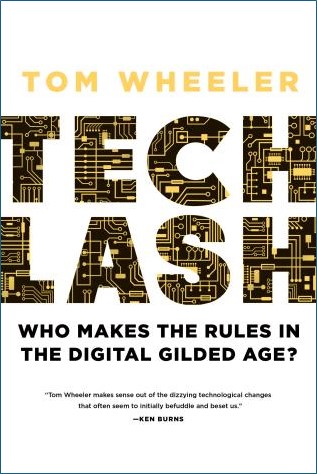Rebalancing the public and private interest, a regulatory opportunity

Before serving as the 31st Chairman of the US Federal Communications Commission (FCC), Tom Wheeler had a distinguished career leading the associations for the cable and mobile wireless industries. He is the only person to have been inducted to both respective Halls of Fame. Wheeler is also a best-selling author of From Gutenberg to Google: The History of Our Future and Mr. Lincoln’s T-Mails: The Untold Story of How Abraham Lincoln Used the Telegraph to Win the Civil War. His latest book Techlash: Who Makes the Rules in the Digital Gilded Age? details the similarities and differences of the technological revolutions of the 19th century and today, the continuous process of entrepreneurial innovation; the growth of wealth and market concentration, and the challenge to protect the rights of individuals and the public interest. Wheeler rejects what he calls “industrial-style regulation for industrial-style management”, the set of top-down, rigid, rules to command and control companies grounded in the 19th century robber baron experience. Regulators must be agile like the companies they regulate. He favors modern digital governance based on agile measures for competition, innovation, and consumer protection. He addresses artificial intelligence (AI) and the metaverse with a vision of privacy, competition, truth, and trust by design. Strand Consult is honored to feature Tom Wheeler in the guest blog below.
By Tom Wheeler
Unregulated tech can damage privacy, competition and truth
The more you look at the original Gilded Age, the more you say, “Wow, does that sound familiar!” Our technology-driven environment today echoes the original Gilded Age, principally because at its root it is the innovators who make the rules without regard for the consequences. We’ve always celebrated the fact that innovators make the rules. They should; they can see the future that none of the rest of us can see. All the great advances in science, technology, business, the arts, came from people who said, “We won’t obey the rules because we see something different.”
But ultimately, that behavior runs into the rights of individuals and the public interest. We saw that in the original Gilded Age, and the Congress responded with antitrust legislation, with the creation of the first federal regulatory agency, with the creation of legislation to protect against unsafe products. And the result of that was incredible growth in the economy and in those companies, as well as protection for consumers and competition.
I think we’re at that same kind of a hinge moment today. The theme of this book is that unregulated tech has a damaging effect on basic things such as privacy, competition, and truth. And you can put in place an agile oversight that will protect the average American and promote innovation by promoting competition. You can then end up rebalancing the public and the private interest. We did it before and we can do it again.
The difference of digital assets
Industrial assets were things you could stub your toes on. Digital assets are soft assets. Industrial assets were expensive; digital assets are inexpensive. Industrial assets were used once and were gone. Digital assets can be used again and again. Industrial assets were rivalrous: if I have a ton of coal, you don’t. But digital assets can be shared. And the industrial assets were exhaustible: you could only use something once. In the digital environment, you can use it again and again and again. Every time you sign up for Facebook, you’re using the same software that somebody else signed up with. Every time you download Microsoft Word, you’re using the same software. It’s inexhaustible.
So, the fact that the assets themselves are different created an economic activity that was different. In the industrial era, it was a pipeline production economy. A hard asset moved through the process until it rolled off the assembly line as a finished product. In the digital era, it is a platform-pairing process, where you create digital assets by pairing them with other digital assets to produce a product.
Guardrail on Big Tech
The question is not only how do we put guardrails around Big Tech, but also how do we do it in a way that continues to encourage innovation? Industrial-style regulation is like industrial-style management. When Congress went to create these industrial agencies that we know today, including the FCC, they looked at how the companies that were to be supervised were being managed. Industrial management was a top-down, rigid, rules-based approach. The guru of industrial management was a fellow by the name of Frederick W. Taylor, and his management techniques were called Taylorism. Basically, his idea was to squeeze all creativity out of everybody, and get them to do exactly the same thing by your rules. And that will give you the best industrial production.
It is just the opposite today. Not only are our companies managed by agile management techniques, in that they’re constantly having to respond to new technology, but they’re also constantly having to respond to marketplace changes. What we need to have new regulators that look like the new style of agile digital management that exists today.
In 1867 the Grange was founded by farmers as a countervailing force to the power of the railroads. Railroads were abusing farmers, and the farmers kept saying, “We need oversight.” But it wasn’t until 1887, 20 years after the Grange was founded, that the Interstate Commerce Commission was created. And it wasn’t until almost 20 years after that that Teddy Roosevelt finally helped to give it some real enforcement teeth. So the point of the matter is, this always takes a long period of time.
I think it needs to move faster now because of the even faster pace of life created by the new technology. I am optimistic that as the American people continue to express themselves about the need for oversight, that Congress will respond.
Everybody says, “Oh, Congress is so controlled by the special interests.” But special interests in the late 19th century owned members of Congress. And still, we had antitrust laws, we had consumer protection laws. I think that, today, we the people need to communicate. The reason things changed in the late 19th century was that we the people, folks like the Grange, folks like the progressive movement and populists, kept saying, “This is enough. We’ve got to do something about that.” And I think that’s the hope for us, in our time.
The Agile Digital Regulatory Agency
We need an agile agency that has a new approach and is built to look like the companies that it is supposed to oversee, rather than built to look like industrial companies that are not part of the digital economy. It’s reverse Taylorism. Where Taylor said we want to squeeze out every incentive for creativity, in digital companies, transparency and creativity are the watchwords. We need to have those same concepts as the watchwords in the oversight of those digital companies.

